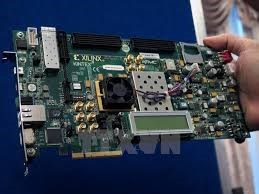
The market for integrated circuits and semiconductors in Việt Nam has huge potential, offering great investment opportunities for domestic and foreign enterprises.
(Source: VNA)
The IC industry offers core support to other industries such as information technology, telecoms, and mechanical and automatic engineering, according to Prof Dang Luong Mo, an expert in integrated circuits.
The Ho Chi Minh City Integrated Circuit Development Programme promotes investment in minimal fab, a small-scale, low-cost method of manufacturing semi-conductors.
The programme, which runs from 2013 to 2020, aims to develop the IC industry through training and research programmes and support to IC manufacturers.
It focuses on incubating integrated-circuit businesses, designing and manufacturing prototypes, promoting semi-conductors and integrated circuit industries, and construction of a new fabrication and a design centre.
Dr Toshilo Wakabayashi of Japan’s Shinshu University said this minimal fab manufacturing is suited to Vietnam and requires much less investment and space compared to normal manufacturing.
"Minimal fab requires only 1/1,000th of the investment that a normal IC manufacturing facility does, and it allows manufacture of chips in a room measuring just a few square metres and provides a great learning opportunity for researchers," he said.
Under the programme, the Saigon Industry Corporation is expected to build a US$330 million silicon chip plant, with production capacity of 5,000 to 10,000 wafers per month.
The chip plant was approved in 2015 by the then Prime Minister Nguyen Tan Dung as part of HCM City's hi-tech industry development strategy.
As one of the most developed areas in Vietnam, HCM City has huge potential to attract investors such as Intel Corp in the integrated circuits and semiconductors sector.
Intel Corporation invested 1 billion USD in a micro-chip plant in Sai Gon Hi-Tech Park in 2006, while the Japanese-invested Juki Vietnam Co Ltd in 2016 purchased two robot arms for nearly 200,000 USD for processing work.
It was among the first companies in Vietnam to use robotic technology to improve the quality of its products.
The robot arms have helped reduce the number of workers at the processing division from 12 to one, and that person only has to monitor the robot’s function.
The same trend can also be seen among the city’s state agencies.
Binh Dan Hospital in late 2016 was the first agency in the health sector to use robots in surgery.
Hospital director Tran Vinh Hung said robotic surgeons had improved quality, and the trend was followed by Cho Ray Hospital.
Facing a storm of technological advancement, many State agencies and businesses located in the southern hub have taken steps to use advanced technologies to improve their performances and product quality.
Nguyen Anh Tuan, Chairman of the HCM City Semi-conductor Industry Association (HSIA), said the biggest challenge for both State agencies and private businesses is finding employees to operate and monitor these technologies.
The training centre at Saigon High-Tech Park said that domestic labourers often do not meet companies' standards.
There are now more than 300,000 enterprises in HCM City and the number is forecast to reach 500,000 in 2020, raising the demand for high-quality labour.
The demand for highly skilled workers has grown at least 20 per cent per year in the last three years, but labour supply cannot meet demand.
A number of companies are looking for highly skilled employees to work on urgent projects, but they have to spend a lot of time and money sourcing staff.
The human aspect remains important as people are the “software” that operate and monitor technologies, Prof. Ho Tu Bao, Director of the John von Neumann Institute at HCM City National University, said.
“We need to develop a strong base of human resources who can use technologies to develop valuable, helpful products, or they will stay at the same low level of skills,” he said./.
VNA
 Da Nang invests over 200 billion VND in semiconductor chip design, AI development
Da Nang invests over 200 billion VND in semiconductor chip design, AI development


